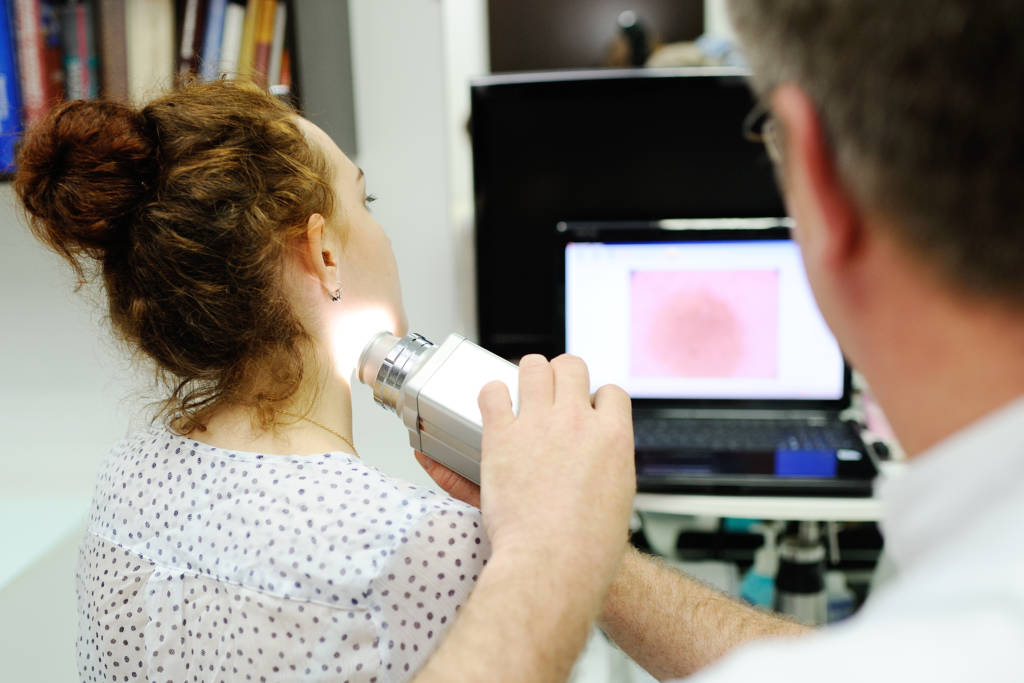This innovative technology can distinguish between a benign lesion on the skin and a malignant one, using a non-invasive, immediate, and automatic process in real-time.
By TPS
Israeli scientists at Tel Aviv University have developed a new optical technology that will enable an automatic and immediate melanoma diagnosis, saving many patients’ lives.
This innovative technology, which is based on special optical fibers, can distinguish between a benign lesion on the skin and a malignant one, using a non-invasive, immediate, and automatic process in real-time.
The technology can also distinguish between types of skin cancer, such as melanoma, a life-threatening type of cancer, and malignancies that are not as dangerous.
The technology was used successfully on about one hundred patients at a major hospital in Israel.
The new method was developed in the laboratory of Professor Abraham Katzir, from the Raymond and Beverly Sackler Faculty of Exact Sciences at Tel Aviv University. The diagnosis is rapid, non-invasive, and causes no pain to the patient.
Professor Katzir said that in the case of melanoma, immediate diagnosis can save lives. He explained that currently when a suspicious lesion is found on the skin, during a routine examination, it is removed in a minor surgical procedure and sent to a laboratory for testing. A pathologist diagnoses the lesion and determines whether it is melanoma.
In most cases where melanoma is discovered early, when it is still superficial and less than one-millimeter-thick, it is removed and the patient recovers. Late diagnosis, when the melanoma is more than one-millimeter-thick, significantly reduces the chances of recovery and is life-threatening.
“The idea that guided us in developing the technology was that in the visible range, there are various substances, having various colors, which are not characteristic of each substance. On the other hand, in the infrared region, various substances have different ‘colors’ of a sort, depending on the chemical makeup of each substance,” Katzir said. “Therefore, we figured that with the help of devices that can identify these ’colors’, healthy skin and each of the benign and malignant lesions would have different ’colors’ which would enable us to identify melanoma.”
Katzir’s research group developed special optical fibers that are transparent in the infrared. The group, in collaboration with physicists Professor Yosef Raichlin of Ariel University, Dr. Max Platkov of the Negev Nuclear Research Center, and Svetlana Bassov of Professor Katzir’s group, developed a system, based on these fibers, which is suitable for the requirements of evaluating skin.
The researchers connected one end of this type of fiber to a device that measures the “colors” in the infrared, and touched the other end lightly, for several seconds, to a lesion on a patient’s skin. The fiber made it possible to check the “colors” of the lesion in real time.
Clinical trials were carried out on suspicious lesions in about one hundred patients. With the new system, physicists performed measurements of the color of each lesion, before it was removed and sent to a pathology laboratory. The researchers showed that all of the lesions that were determined by pathologists as being of a certain type, such as melanoma, had a characteristic color in the infrared. Each lesion of a different type had a different color.
“This technology gives us a kind of ‘fingerprint’ that makes a clear diagnosis of the various lesions possible, by measuring their characteristic ’colors,’” says Katzir. “In this way, lesions can be diagnosed using a non-invasive optical method, and the physician and the patient receive the results automatically and immediately. This is unlike the test that is routinely used, which involves surgery, and the pathological diagnosis takes a long time.”
Following the success of the study, the researchers plan to confirm the evaluation method on hundreds of patients.
In conclusion, Professor Katzir noted that the innovative system will enable dermatologists to determine the character of a suspicious lesion automatically, and particularly if it is melanoma. This system has the potential to cause a dramatic change in the field of diagnosing and treating skin cancer, and perhaps other types of cancer as well. The challenge will be to make this technology, which is still expensive, something that will be used in every hospital or clinic.”
MAKE THE LAND OF ISRAEL EVEN MORE BEAUTIFUL!
PLANT YOUR VERY OWN FRUIT TREES IN ISRAEL!
Farmers near the Gaza border lost family, friends and workers. Spring is here, and they desperately need help to replant the farms. Join us in blessing the People and Land of Israel.
“I will ordain My blessing for you…” (Leviticus 25:4)
